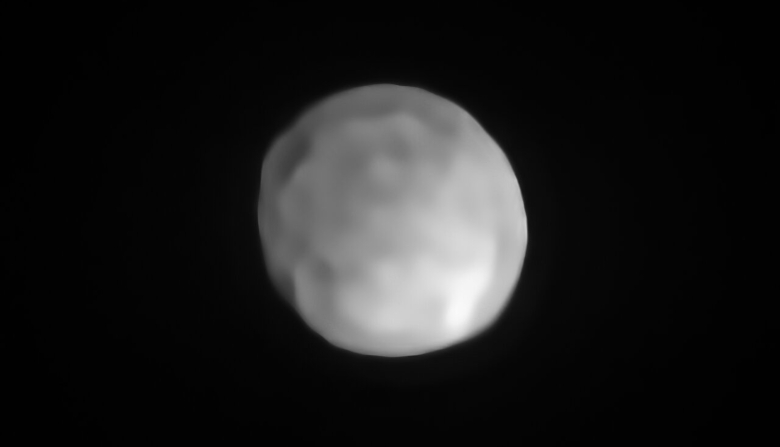Astronomers using ESO’s SPHERE instrument at the Very Large Telescope (VLT) could be about to give the fourth largest object in the asteroid belt a promotion, as new observations of Hygiea have revealed that this sizeable space rock is spherical, meaning that it has enough mass for its own gravity to pull it into a roughly round shape.
Based on spectral evidence, Hygiea, which was first discovered in 1849, is thought to consist mostly of carbon – a material similar to that found in carbonaceous chondrite (stony, non-metallic) meteorites.
It is the largest of the class of dark C-type asteroids that are dominant in the outer asteroid belt but it still lags behind the largest of the asteroids, Ceres and Vesta and Pallas in the mass and volume department.
At present, Ceres is currently the only unambiguous dwarf planet inside Neptune's orbit.
So what does it take to be classified as a dwarf planet? As an object in the main asteroid belt, Hygiea already satisfies three of the four requirements: it is not a moon or satellite of another object, it orbits around the Sun, and, unlike a planet like Earth or Venus, it has not cleared the neighbourhood around its orbit. This last requirement is what stops objects like Ceres from being classified as a full blown planet.
The final requisite is that a body has to have sufficient mass for its self-gravity to overcome rigid-body forces so that it assumes a hydrostatic equilibrium (nearly round) shape; a qualification that both Vesta and Pallas fail on.
However, thanks to these recent VLT observations Hygiea might not suffer the same fate as they confirm that the asteroid fulfils that last criteria. If accepted, Hygiea would be anointed with a new classification and a new title.
“Thanks to the unique capability of the SPHERE instrument on the VLT, which is one of the most powerful imaging systems in the world, we could resolve Hygiea’s shape, which turns out to be nearly spherical,” says lead researcher Pierre Vernazza from the Laboratoire d'Astrophysique de Marseille in France. “Thanks to these images, Hygiea may be reclassified as a dwarf planet, so far the smallest in the Solar System.”
The SPHERE observations have also helped the team to constrain Hygiea’s size. Its diameter had been suggested to be anything from 350 - 500 kilometres, but it has now been constrained to be just over 430 km. For comparison Ceres diameter is close to 950 kilometres in size, whilst Pluto, the is it or isn’t it a dwarf planet, has a diameter close to 2400 kilometres.
Controversy still remains about Pluto’s status after the International Astronomical Union (IAU) voted to demote the planet to that of a dwarf one in 2006. Some still feel that the planet with a heart should never have been relegated, but as a precise definition of "planet” has been never formulated to everyone’s agreement, the debate still rages on.
As the main member of one of the largest asteroid families, with close to 7000 smaller siblings, that all originated from the same parent body, Hygiae however could not be mistaken for a full planet.
Surprisingly, roaming about in such close proximity to other large space rocks seems to have left hardly any tell tale impact impression on Hygiea. Scientists had expected the event that led to the formation of this large rock family to have left a large, deep impression on the asteroid, but none were found in the observations.
“This result came as a real surprise as we were expecting the presence of a large impact basin, as is the case on Vesta,” says Vernazza. Although the astronomers observed Hygiea’s surface with a 95 percent coverage, they could only identify two unambiguous craters. “Neither of these two craters could have been caused by the impact that originated the Hygiea family of asteroids whose volume is comparable to that of a 100 km-sized object. They are too small,” explains study co-author Miroslav Brož of the Astronomical Institute of Charles University in Prague, Czech Republic.
After running a number of simulations to try and shed some light on what could have happened, it is now thought that about 2 billion years ago, the once much larger asteroid smacked head on into another object between 75 and 150 kilometres in diameter, completely shattered the parent body. The left over pieces then reformed to produce a rounded Hygiea and thousands upon thousands of smaller close companions.
“Such a collision between two large bodies in the asteroid belt is unique in the last 3–4 billion years,” says Pavel Ševeček, a PhD student at the Astronomical Institute of Charles University who also participated in the study.
With advances in numerical computation, and more powerful telescopes, scientists are now more able to rewind the clock and piece together cosmic conundrums such as these.
“Thanks to the VLT and the new generation adaptive-optics instrument SPHERE, we are now imaging main belt asteroids with unprecedented resolution, closing the gap between Earth-based and interplanetary mission observations,” Vernazza concludes.











